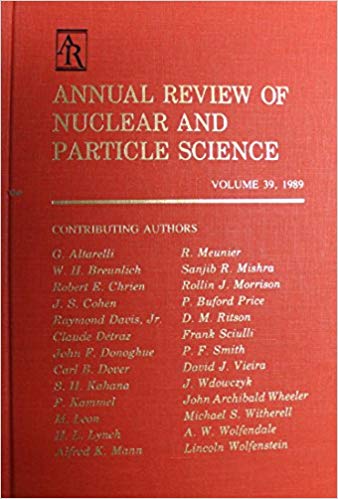ΛCDM宇宙学中的星系形成
IF 9.1
2区 物理与天体物理
Q1 PHYSICS, NUCLEAR
Annual Review of Nuclear and Particle Science
Pub Date : 2024-06-17
DOI:10.1146/annurev-nucl-102622-023052
引用次数: 0
摘要
这是星系形成的黄金时代:现有的,特别是新的望远镜所提供的观测结果,对迅速改进的理论和模拟提出了挑战,也为其提供了启示。这篇综述描述了宇宙网的形成以及为宇宙提供支架的暗物质晕的结构。然后概述了经验模型、半解析模型和流体力学模拟如何试图解释星系群的关键特性,包括恒星形成星系的主序、恒星形成的低效率、星系的形状演化和颜色双峰性,以及导致星系熄灭恒星形成的现象。最后,它总结了对星系形成的宇宙常数冷暗物质(ΛCDM)范式提出质疑的观测结果--包括哈勃和S 8张力、早期宇宙中的明亮星系、银河系外背景光之谜、失踪的卫星星系、矮星系的多样性、尖核问题、大而不倒问题、恒星团块、卫星星系平面和没有暗物质的星系--以及提出的解决方案。本文章由计算机程序翻译,如有差异,请以英文原文为准。
Galaxy Formation in ΛCDM Cosmology
This is a golden age for galaxy formation: Existing and especially new telescopes are providing observations that challenge and illuminate rapidly improving theory and simulations. This review describes the formation of the cosmic web and the structure of the dark matter halos that provide the scaffolding of the Universe. It then summarizes how empirical models, semianalytic models, and hydrodynamic simulations attempt to account for key properties of the galaxy population, including the main sequence of star-forming galaxies, the inefficiency of star formation, the shape evolution and color bimodality of galaxies, and the phenomena that cause galaxies to quench their star formation. It concludes with a summary of observations that have challenged the cosmological constant cold dark matter (ΛCDM) paradigm of galaxy formation—including the Hubble and S 8 tensions, bright galaxies in the early Universe, an extragalactic background light mystery, missing satellite galaxies, the diversity of dwarf galaxies, the cusp–core problem, the too-big-to-fail problem, stellar clumps, planes of satellite galaxies, and galaxies without dark matter—and solutions that have been proposed.
求助全文
通过发布文献求助,成功后即可免费获取论文全文。
去求助
来源期刊
CiteScore
21.50
自引率
0.80%
发文量
18
期刊介绍:
The Annual Review of Nuclear and Particle Science is a publication that has been available since 1952. It focuses on various aspects of nuclear and particle science, including both theoretical and experimental developments. The journal covers topics such as nuclear structure, heavy ion interactions, oscillations observed in solar and atmospheric neutrinos, the physics of heavy quarks, the impact of particle and nuclear physics on astroparticle physics, and recent advancements in accelerator design and instrumentation.
One significant recent change in the journal is the conversion of its current volume from gated to open access. This conversion was made possible through Annual Reviews' Subscribe to Open program. As a result, all articles published in the current volume are now freely available to the public under a CC BY license. This change allows for greater accessibility and dissemination of research in the field of nuclear and particle science.

 求助内容:
求助内容: 应助结果提醒方式:
应助结果提醒方式:


